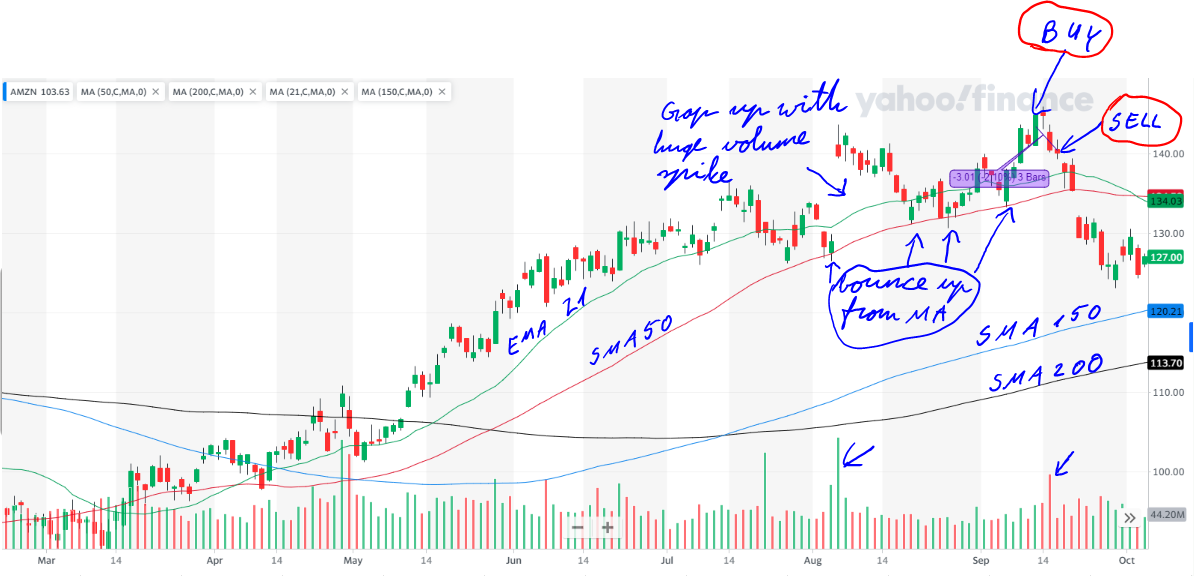Introduction
Investing in stocks can be both exciting and challenging. It involves analyzing various factors, setting up strategies, and making decisions that can lead to either profits or losses. In this blog post, I’ll share my experience with a recent stock purchase of Amazon (AMZN) on September 13, 2023, and discuss the outcomes, what went well, areas for improvement, and overall considerations.
The Purchase
On the 13th of September, 2023, I made a strategic decision to buy Amazon (AMZN) at a price of $144.19. Here are the key details of that trade:
Price: $144.19
Stop Loss: $135.54
Profit Target: $173.03
Market Analysis
To make informed investment decisions, it’s crucial to analyze the market conditions thoroughly.
Market Trend
At the time of my purchase, the overall market was in a confirmed uptrend, providing a favorable backdrop for stock investments.
Stock Performance
Amazon had risen 1.8 times from its lowest point at the base. This indicated a healthy upward trend, although it was still under the 2x mark, suggesting it was a relatively good buying point.
RS Rating
Amazon’s Relative Strength (RS) rating was 94, indicating that the stock was outperforming at least 94% of other stocks in the market. This was a positive sign.
Position Risk
The position risk for this trade was calculated at 5.96%, which was considered reasonable given the current uptrend in the market.
Net LIQ Risk
The net liquidation risk for this particular position was a mere 0.37%, indicating a minimal risk exposure. ‘Net Liquidation’ refers to the total value of the trading account at any specific time.
Adhering to my personal guideline, I aim to keep the net liquidation risk limited to a maximum of 2% per trade. Having encountered a string of losses over the past few months, my approach has become more risk-averse, with efforts to cap the risk at no more than 0.5% of the account’s value. From this perspective, there was room to assume a larger risk on this trade.
Position Size
My initial position size was about 6%, with a planned position size of 10%. This was not my first buy of AMZN; it was an addition to an existing position.
IDEAL BUY

I deemed it a prime purchasing opportunity. As illustrated in the preceding image, multiple positive indicators favored acquiring the stock.
The stock was manifestly on an upward trajectory, with its price comfortably positioned above all critical moving averages, yet not excessively distant from the 21-day Exponential Moving Average (EMA 21).
There was a noticeable rebound in the stock price off the moving averages, accompanied by significant surges in trading volume.
Furthermore, the stock’s price was not overly stretched—it hadn’t soared to many times its value compared to the most recent closure above the 200-day Simple Moving Average (SMA 200).
Collectively, these signals bolstered my conviction that the conditions for purchase were as favorable as possible.
The Decision to Close
However, my enthusiasm was short-lived, as I had to close the Amazon position on the 18th of September at a price of $140.08. Several factors influenced this decision.
RS Rating Decline
By the time I closed the position, AMZN’s RS rating had decreased to 92, indicating a slight decline of relative strength in the stock.
Falling Price
The primary reason for closing the position was that the stock price was starting to decline, and I wanted to reduce my exposure to potential losses. Also, the price had sank below EMA 21.
What Went Well
Despite the negative outcome, there were some positive aspects to this trade:
Timely Selling
I managed to sell on the third consecutive down day, showing discipline and not letting the position linger too long.
Strong Entry Point
I initiated the position on a day when the stock was performing well, which was a good entry point.
Disciplined Selling
I made the decision to exit above the stop-loss level, not waiting for the stop-loss to trigger, which was a disciplined approach.
Areas for Improvement
No investment is without its lessons. Here are some considerations for improvement:
Early Exit
Should I consider selling sooner when a position starts declining immediately after purchase? For instance, when the price falls below the low of the first 7 days. This could be a strategy to limit losses.
Final Thoughts
In the end, my overall profit from this trade was negative, with a loss of 4.91%. The position loss related to my portfolio was 0.26%. Given that the position was open for only 3 trading days, it went south quite rapidly. This experience has led me to consider liquidating positions that start losing money immediately.
Conclusion
While this AMZN trade seemed like an ideal buy at first, it serves as a reminder that even the best setups don’t always work out as planned. It’s crucial to continually evaluate strategies and learn from both successful and unsuccessful trades. Additionally, I’ve come to realize that I should be cautious about buying stocks with volatile days in the chart base, as they can lead to unpredictable outcomes in the short term.
It’s worth pondering a redefinition of ‘success’ in the context of investing and trading. While I previously characterized the trade as unsuccessful, that assessment might have been premature. Here’s my rationale:
The trade was initiated based on meticulous analysis and executed with precision, adhering strictly to the pre-established plan without resorting to after-the-fact justifications. I maintained discipline in my position sizing, avoiding the pitfall of overcommitment. In essence, my actions were aligned with best practices designed to optimize the trade’s potential for success. Since the market’s movements and the specific price actions of assets are beyond our influence, our role is limited to strategically reacting to these factors. Therefore, in light of our adherence to a sound strategy and process, perhaps the trade should indeed be considered a success, irrespective of its profitability.


